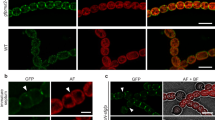Abstract
The leech photoreceptor forms a unicellular epithelium: every cell surrounds an extracellular “vacuole” that is connected to the remaining extracellular space via narrow clefts containing pleated septate junctions. We analyzed the complete structural layout of all septa within the junctional complex in elastic brightfield stereo electron micrographs of semithin serial sections from photoreceptors infiltrated with colloidal lanthanum. The septa form tortuous interseptal corridors that are spatially continuous, and open ended basally and apically. Individual septa seem to be impermeable to lanthanum; interseptal corridors form the only diffusional pathway for this ion. The junctions form no diffusion barrier for the electron-dense tracer Ba2+, but they hinder the diffusion of various hydrophilic fluorescent dyes as demonstrated by confocal laser scanning microscopy (CLSM) of live cells. Even those dyes that penetrate gap junctions do not diffuse beyond the septate junctions. The aqueous diffusion pathway within the septal corridors is, therefore, less permeable than the gap-junctional pore. Our morphological results combined with published electrophysiological data suggest that the septa themselves are not completely tight for small physiologically relevant ions. We also examined, by CLSM, whether the septate junctions create a permeability barrier for the lateral diffusion of fluorescent lipophilic dyes incorporated into the peripheral membrane domain. AFC16, claimed to remain in the outer membrane leaflet, does not diffuse beyond the junctional region, whereas DiIC16, claimed to flip-flop, does. Thus, pleated septate junctions, like vertebrate tight junctions, contribute to the maintenance of cell polarity.
Similar content being viewed by others
Author information
Authors and Affiliations
Additional information
Received: 8 December 1997 / Accepted: 3 March 1998
Rights and permissions
About this article
Cite this article
Aschenbrenner, S., Walz, B. Pleated septate junctions in leech photoreceptors: ultrastructure, arrangement of septa, gate and fence functions. Cell Tissue Res 293, 253–269 (1998). https://doi.org/10.1007/s004410051117
Issue Date:
DOI: https://doi.org/10.1007/s004410051117




